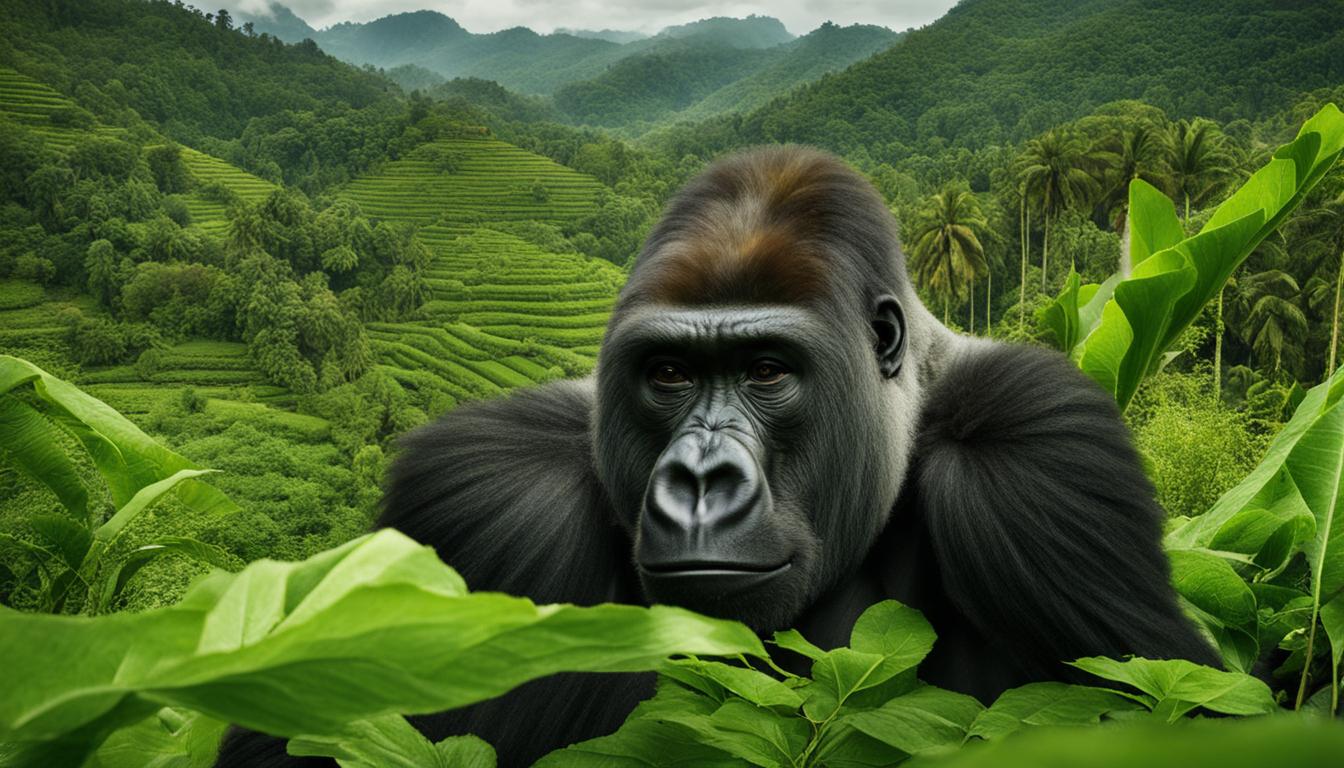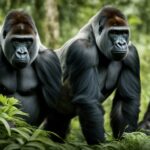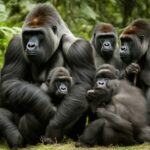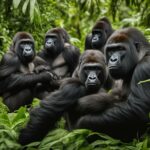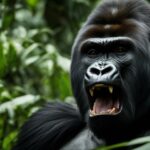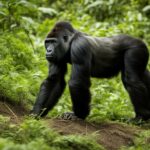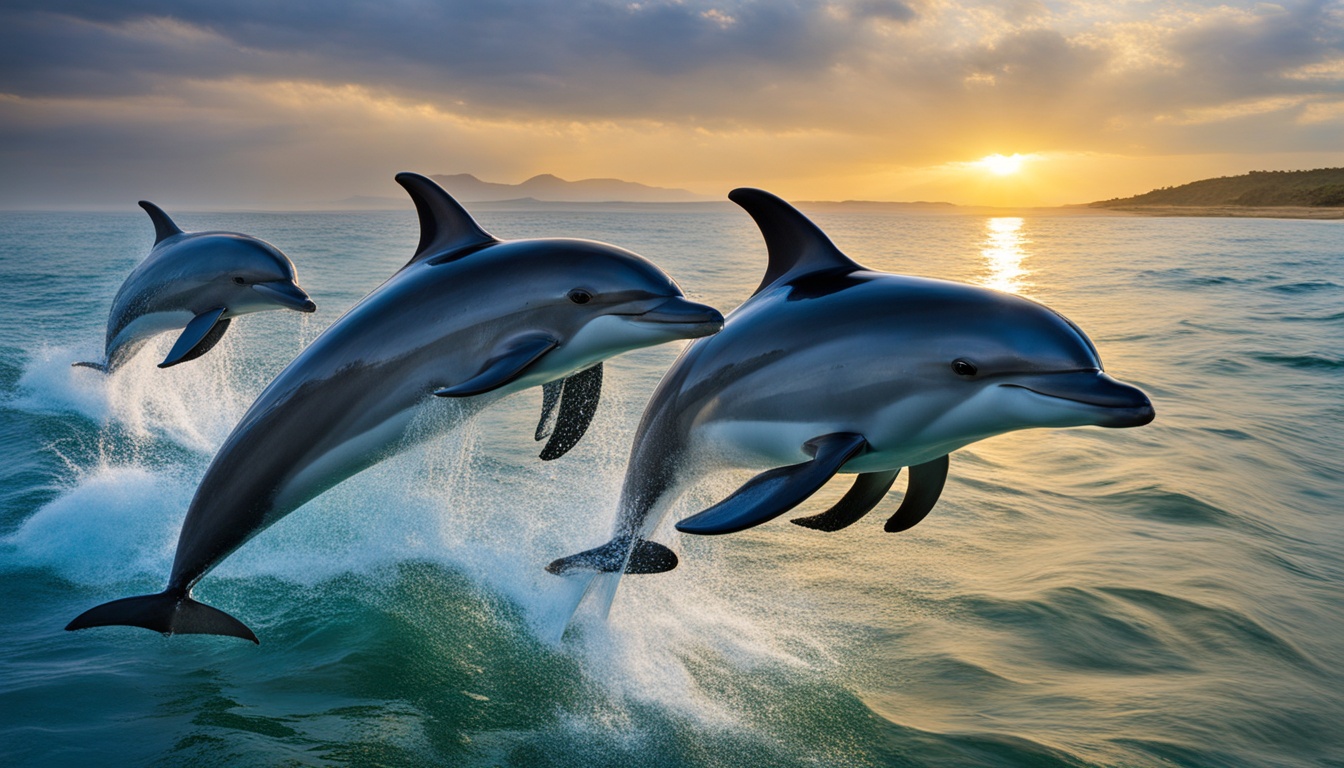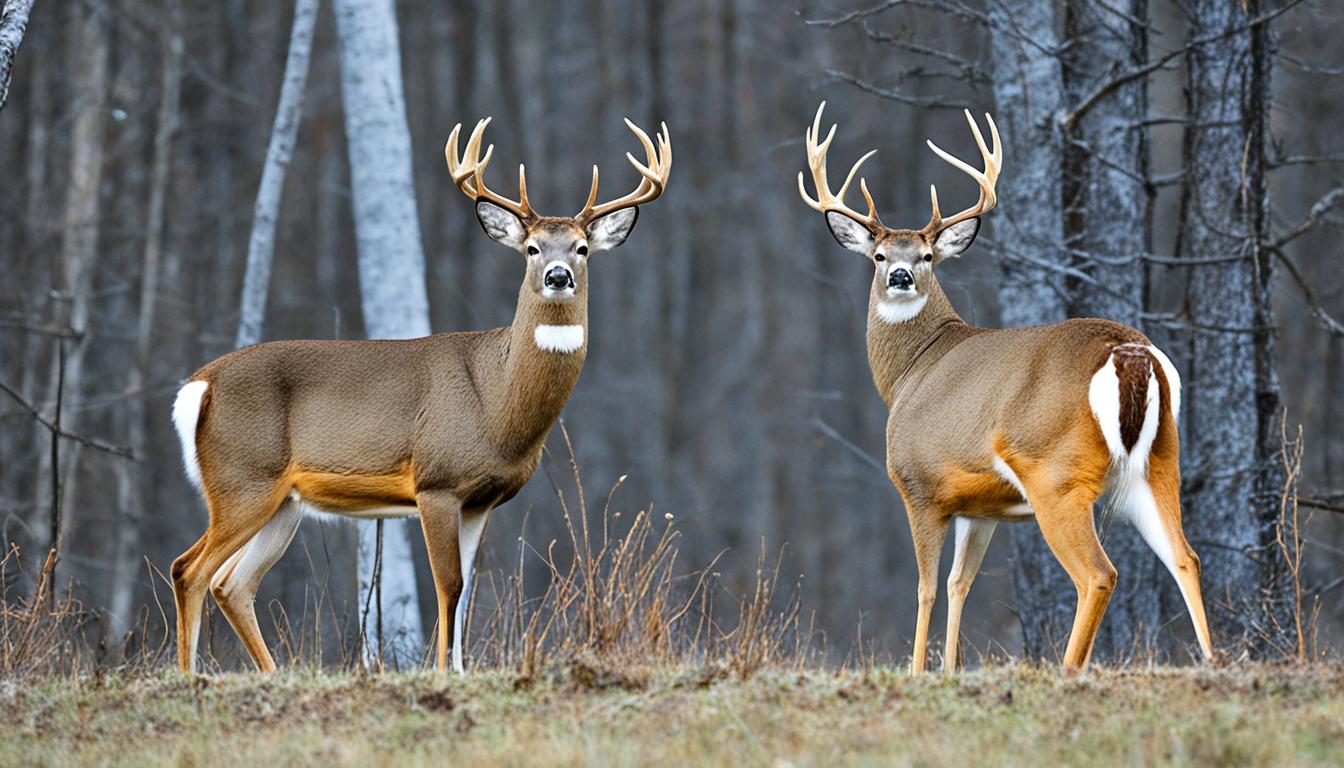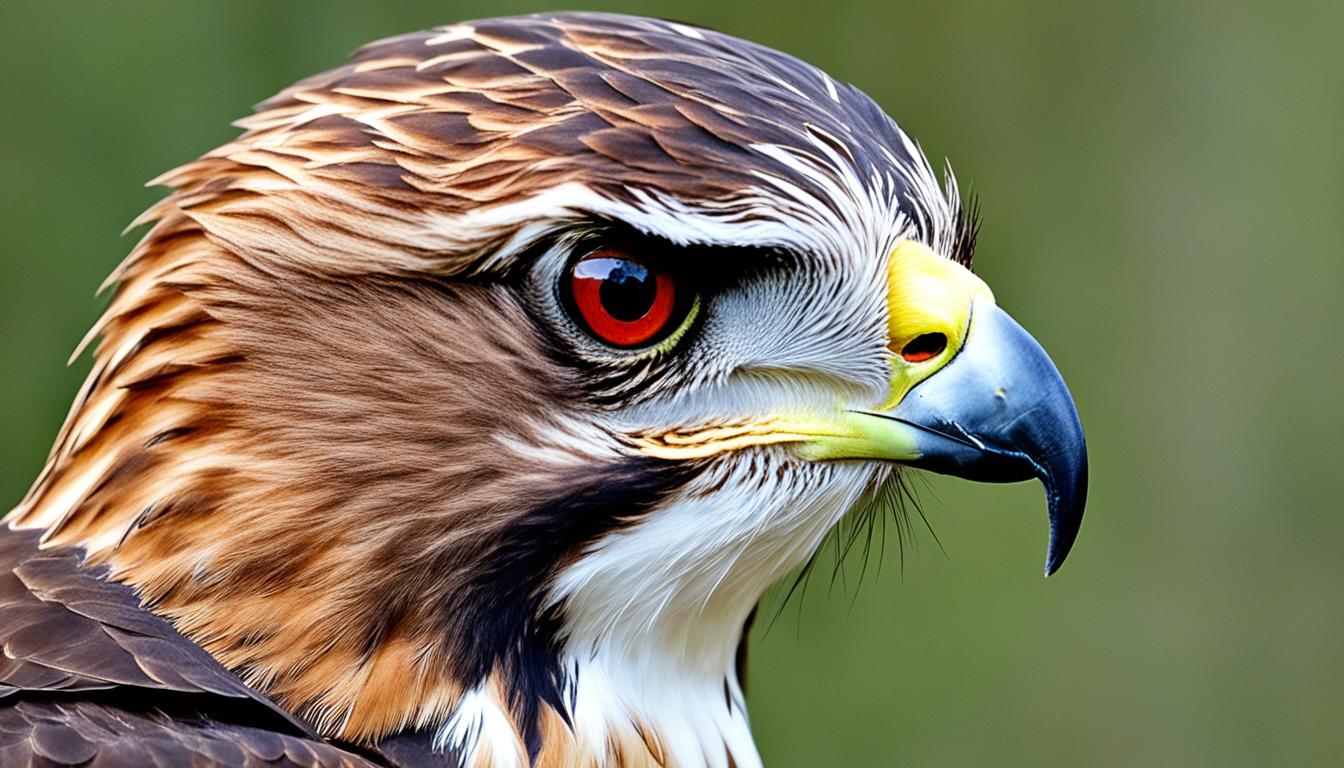Gorillas, as the largest of the great apes, play a crucial ecological role in the forests of Central Africa. However, their future is threatened by various factors including poaching, habitat degradation and loss due to mining, logging, and agriculture, as well as diseases like Ebola. These threats have a significant impact on gorilla populations and their habitats.
Understanding the relationship between gorillas and agriculture is vital for gorilla conservation and the protection of wildlife. Farming practices and their impact on gorilla habitats need to be examined to ensure the sustainable coexistence of agriculture and these magnificent creatures.
Habitat Degradation and Agricultural Impact on Gorilla Habitats
Gorillas, as the largest of the great apes, play a vital role in the forests of Central Africa. However, their habitats are under immense pressure from habitat degradation caused by various human activities, including mining, commercial logging, subsistence agriculture, road building, and the illegal bushmeat trade. These activities pose a significant threat to the survival of wild gorilla populations.
Mining activities, such as the extraction of minerals like coltan, have led to the rapid destruction of gorilla habitats. The excavation process often involves clearing large areas of forests, resulting in habitat loss and fragmentation. Commercial logging also contributes to habitat degradation as valuable timber is harvested, further reducing the available habitat for gorillas.
Subsistence agriculture, driven by the need for food and livelihoods, also takes a toll on gorilla habitats. Local communities clear forests to make way for farming, leading to the conversion of critical gorilla habitat into agricultural land. Road building for transportation purposes further exacerbates the situation, opening up previously inaccessible areas and increasing human encroachment into gorilla territories.
The illegal bushmeat trade, closely linked to habitat degradation, poses a severe threat to gorillas. These intelligent animals are targeted for consumption, and their body parts are used in traditional medicines. The demand for bushmeat drives hunting activities, further impacting gorilla populations. As a result, gorillas face a significant challenge in their struggle for survival amidst the ongoing agricultural activities.
The Impact of Agricultural Practices on Gorilla Habitats
The degradation and loss of gorilla habitats have severe consequences for their populations. Habitat fragmentation leads to the isolation of gorilla groups, limiting their gene pool and increasing the risk of inbreeding. This genetic bottleneck reduces their resilience to environmental changes and makes them more vulnerable to diseases.
Furthermore, gorilla habitats are also crucial for maintaining the balance of ecosystems. Gorillas play a vital role in seed dispersal as they consume fruits and plants and distribute seeds through their feces. Their browsing habits and ability to break apart vegetation also create openings in the forest canopy, allowing sunlight to reach the forest floor and benefit other species.
| Threats to Gorilla Habitats | Impact on Gorilla Populations |
|---|---|
| Mining | Rapid destruction and fragmentation of habitats, reduced gene pool |
| Commercial logging | Habitat destruction, loss of valuable timber, reduced habitat availability |
| Subsistence agriculture | Habitat conversion, increased human encroachment, limited food resources |
| Road building | Increased human access, habitat fragmentation |
| Illegal bushmeat trade | Hunting, reduced gorilla populations, disrupted ecosystems |
It is crucial to address the agricultural impact on gorilla habitats to ensure the long-term survival of these magnificent creatures. Efforts must focus on sustainable agricultural practices that minimize habitat destruction and promote coexistence between humans and gorillas. Conservation initiatives, such as community-based conservation programs and protected area management, can play a significant role in mitigating the agricultural impact and safeguarding gorilla habitats.
Quote: “The degradation of gorilla habitats due to agricultural activities is pushing these incredible animals closer to the brink of extinction. It is imperative that we take immediate action to protect their habitats and promote sustainable practices that benefit both humans and gorillas.” – Wildlife Conservation Society
Hunting, Poaching, and Conservation Efforts
Poaching of gorillas for bushmeat and other purposes, such as traditional medicine, is a major threat to wild gorilla populations. Even low levels of poaching can have long-lasting impacts on gorilla populations due to their low reproductive rate. Gorillas are also unintentionally caught in traps set for other animals. In response to these threats, there are various gorilla conservation programs in place to protect and conserve gorilla populations.
Gorilla Poaching and Bushmeat Trade
Illegal hunting and poaching of gorillas for their meat, known as the bushmeat trade, poses a significant risk to gorilla populations. Gorillas are highly prized for their meat, which is considered a delicacy in some regions. This demand drives the illicit trade, leading to the indiscriminate killing of gorillas across their range. Poachers often use wire snares and guns to capture or kill gorillas, causing immense suffering and devastating population declines.
Gorilla Conservation Programs
To combat the threats of hunting and poaching, various organizations and conservation programs are working tirelessly to protect and conserve gorilla populations. These programs focus on multiple strategies, including anti-poaching patrols, community engagement, education, and alternative livelihoods for local communities. They aim to raise awareness about the importance of gorilla conservation, provide incentives for sustainable practices, and support law enforcement efforts to combat illegal hunting and trade.
| Gorilla Conservation Programs | Description |
|---|---|
| The Dian Fossey Gorilla Fund International | A non-profit organization dedicated to gorilla conservation through scientific research, education, and community-based initiatives. |
| African Wildlife Foundation | An organization working to protect gorillas and other wildlife by enhancing law enforcement, supporting local communities, and promoting sustainable development. |
| International Gorilla Conservation Programme | A collaborative effort between the African Wildlife Foundation, Fauna & Flora International, and the World Wide Fund for Nature to protect gorillas and their habitats through on-the-ground conservation actions. |
“Gorilla conservation programs play a crucial role in safeguarding these magnificent creatures from the threats of hunting and poaching. By actively engaging local communities and promoting sustainable practices, we can create a future where gorillas can thrive in their natural habitats.” – Conservationist Jane Goodall
Through the collective efforts of conservation organizations, local communities, and governments, there is hope for the survival and recovery of gorilla populations. Continued support for conservation programs, strengthened law enforcement, and sustainable agricultural practices are essential in ensuring a future where gorillas can coexist with humans and thrive in their natural habitats.
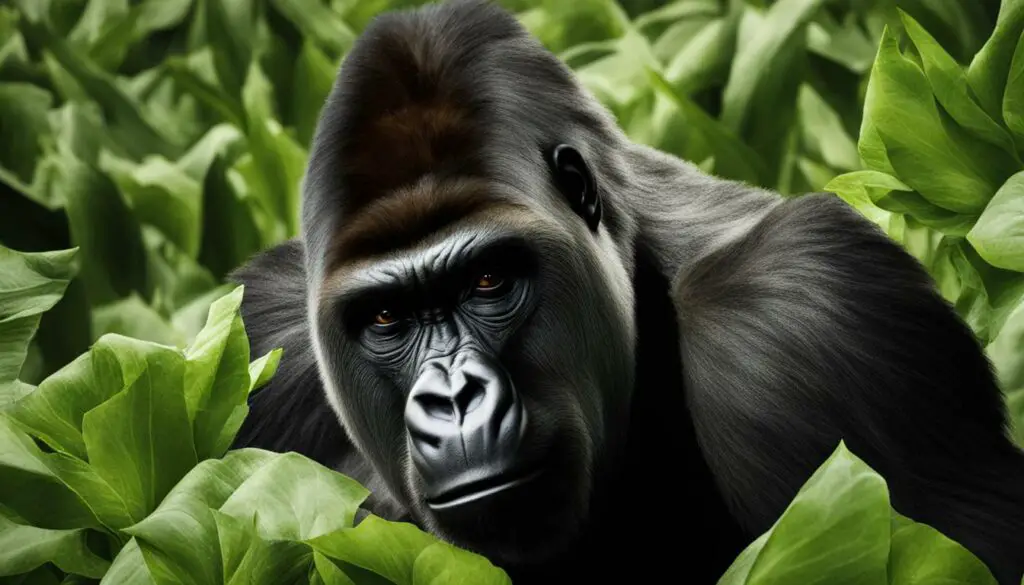
Gorillas and Agriculture in Maiko National Park
Maiko National Park, located in the Democratic Republic of the Congo, is a critical habitat for Grauer’s gorillas, an endangered subspecies. Unfortunately, the park faces several threats, including artisanal mining and the bushmeat trade, which have significant implications for gorilla conservation efforts. The demand for minerals like coltan drives artisanal mining activities, leading to habitat degradation and fragmentation. Additionally, the bushmeat trade poses a major threat to gorillas as they are hunted for consumption and for the use of their body parts in traditional medicines.
Rising populations outside of Maiko National Park further exacerbate the challenges faced by gorillas. As villages expand, they encroach on the park’s primary forests for subsistence farming, putting additional pressure on wildlife and their habitats. This expansion and deforestation not only decrease the available habitat for gorillas but also contribute to the loss of biodiversity in the region.
However, amidst these threats, local communities have become crucial allies in gorilla conservation efforts. Working in collaboration with non-governmental organizations (NGOs), these communities are actively involved in initiatives that promote sustainable development in the region. By implementing sustainable agricultural practices and alternative livelihood options, such as ecotourism, these efforts aim to reduce the reliance on activities that harm gorilla populations while supporting the economic and social well-being of local communities.
| Threats | Implications |
|---|---|
| Artisanal Mining | Habitat degradation and fragmentation |
| Bushmeat Trade | Gorilla hunting and population decline |
| Subsistence Farming | Deforestation and loss of biodiversity |
Protecting Maiko National Park and its gorilla populations requires a multi-faceted approach that addresses both the immediate threats and the underlying causes. This includes enforcing regulations against illegal activities, supporting sustainable agriculture practices, and promoting alternative income-generating opportunities for local communities. By striking a balance between conservation efforts and sustainable development, we can protect the critically endangered gorillas and the invaluable ecosystems they inhabit.
Gorillas and Sustainable Development
Sustainable development plays a crucial role in gorilla conservation in Maiko National Park. By integrating conservation goals with the needs of local communities, sustainable development initiatives aim to alleviate poverty and reduce reliance on activities that harm gorilla habitats and populations. These initiatives often involve training local farmers on sustainable farming techniques, promoting agroforestry practices, and providing support for the establishment of alternative livelihoods, such as eco-tourism ventures.
“Sustainable development is not just about protecting the environment; it is about finding ways to improve the well-being of both people and nature. By working together, we can ensure a future where gorillas and local communities thrive.”
The success of sustainable development efforts in Maiko National Park depends on the collaboration between local communities, NGOs, and government agencies. Through education, capacity building, and the empowerment of local communities, these initiatives strive to create a sustainable future where both gorillas and humans can coexist harmoniously.
Gorilla Behavior and Importance in Ecosystems
Gorillas are fascinating creatures with complex behaviors that play a crucial role in the ecosystems they inhabit. Understanding their behavior and the impact they have on forests is essential for conserving these magnificent animals and maintaining the overall health of their habitats.
In terms of behavior, gorillas are highly social animals that live in family groups called troops. Within these troops, there is a clearly defined social structure, with dominant males, adult females, and their offspring. They communicate through a combination of vocalizations, gestures, and facial expressions, allowing them to convey emotions and coordinate group activities.
One of the most significant ways that gorillas contribute to their ecosystems is through their foraging habits. Gorillas mainly consume plants and fruits, and as they move through their habitats, they disperse seeds through their feces. This dispersal helps to regenerate forests and maintain biodiversity. Additionally, gorillas’ feeding behavior involves pulling apart vegetation, which allows sunlight to penetrate the forest floor, benefiting other species by creating new growth opportunities.
“Gorillas play a vital role in the health and balance of their ecosystems through their foraging habits and seed dispersal. Their impact is not only crucial for forest regeneration but also for the survival of other plant and animal species in their habitats.”
– Conservationist Dr. Jane Goodall
| Impact of Gorillas on Forests | Explanation |
|---|---|
| Gorilla foraging habits | By consuming plants and fruits, gorillas help control vegetation growth and maintain the balance of plant species in forests. |
| Seed dispersal | Through their feces, gorillas spread seeds across their habitats, contributing to forest regeneration and biodiversity. |
| Vegetation disruption | Gorillas’ strength allows them to break apart vegetation, creating openings in the forest canopy for sunlight to reach the forest floor, benefiting other plant species. |
Conservation Implications
Understanding the behavior and ecological importance of gorillas highlights the critical need for their conservation. Protecting gorilla populations and their habitats is vital not only for the survival of these endangered species but also for maintaining the integrity and functionality of their ecosystems. Conservation efforts should focus not only on combating threats like poaching and habitat degradation but also on promoting sustainable practices that allow gorillas and local communities to coexist harmoniously.
Conclusion
Gorillas, the largest of the great apes, are facing numerous threats to their population and habitat. Habitat degradation, hunting, and poaching have resulted in significant declines in Gorilla populations. To ensure their survival, conservation efforts are crucial.
Gorilla protection programs play a vital role in safeguarding these critically endangered species. By implementing sustainable agriculture practices, we can strike a balance between the needs of local communities and the preservation of gorilla habitats. This approach promotes long-term conservation success.
Conserving gorillas is not only important for the survival of the species but also for the health and biodiversity of the forests they inhabit. By protecting gorillas, we contribute to the overall well-being of their ecosystems. It is imperative that we continue these efforts to secure a future for gorilla populations and their habitats.
In what ways do gorillas and chimpanzees both impact agriculture in their habitats?
Gorillas and chimpanzees in agricultural habitats can impact crops by raiding farms for food. They also contribute to seed dispersal through their foraging activities, which can help maintain plant diversity. However, their presence can lead to conflicts with humans over crop damage, posing challenges for sustainable agriculture.
FAQ
How do gorillas relate to agriculture in their habitats?
Gorillas can be impacted by agriculture in their habitats through habitat degradation caused by farming practices. The expansion of agriculture leads to the loss and fragmentation of gorilla habitats, making them more vulnerable to threats such as poaching and diseases.
What are the primary threats to gorillas?
The primary threats to gorillas include poaching, habitat degradation and loss due to mining, logging, and agriculture, as well as diseases like Ebola. These factors are worsened by conflict and poor governance in gorilla habitats.
How does habitat degradation affect gorilla populations?
Habitat degradation caused by activities such as mining, commercial logging, subsistence agriculture, and road building poses a significant threat to wild gorilla populations. It leads to habitat loss, fragmentation, inbreeding, and increased susceptibility to diseases.
What is the impact of the illegal bushmeat trade on gorillas?
The illegal bushmeat trade, linked to habitat loss, poses a major threat to gorillas. They are targeted for consumption and for body parts used in traditional medicines. This trade contributes to the decline of gorilla populations and disrupts the balance of ecosystems.
How does poaching affect gorilla populations?
Poaching of gorillas for bushmeat and other purposes is a major threat to their populations. Even low levels of poaching can have long-lasting impacts due to gorillas’ low reproductive rate. Gorillas are also unintentionally caught in traps set for other animals.
What conservation efforts are in place to protect gorillas?
Various gorilla conservation programs exist to protect and conserve gorilla populations. These efforts include anti-poaching measures, habitat restoration, community engagement, and education initiatives to raise awareness about the importance of gorilla conservation.
What are the threats faced by gorillas in Maiko National Park?
Maiko National Park, home to endangered Grauer’s gorillas, faces threats from the bushmeat trade and artisanal mining driven by the demand for minerals like coltan. Rising populations outside the park also put pressure on wildlife as villages expand and encroach on primary forests.
Why are local communities important in gorilla conservation?
Local communities are crucial allies in gorilla conservation efforts. By working with NGOs, they can help achieve sustainable development in the region, which benefits both the communities and the gorillas. Engaging and empowering local communities is essential for successful long-term conservation.
What is the role of gorillas in ecosystems?
Gorillas play a vital role in ecosystems. Their foraging habits help maintain the health of forests as they consume plants and fruits, spreading seeds through their faeces. Gorillas’ strength also helps in vegetation management, allowing sunlight to reach the forest floor and benefiting other species.
Why is it important to protect gorillas?
Protecting gorillas is crucial for the preservation of a critically endangered species. It also helps maintain the biodiversity and health of forests in their habitats. Conservation efforts, including gorilla protection programs and sustainable agriculture practices, are essential for the survival of gorillas and their ecosystems.

